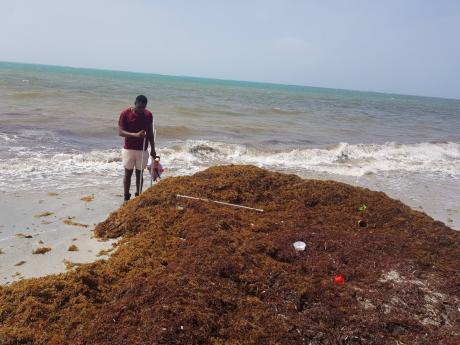NEPA, UWI partner to conduct research on sargassum
The National Environment and Planning Agency (NEPA) has partnered with a multidisciplinary team from the Faculty of Science and Technology at The University of the West Indies, Mona, to conduct research on the seaweed, sargassum.
The research will look at several usefulness of the seaweed, including its use as a fertiliser and how bioactive compounds and other valuable substances can be extracted from it, as well as sargassum’s potential use in the generation of energy in biodigesters.
In other parts of the Caribbean, sargassum is used as animal feed, food for humans, in cosmetics, the manufacture of take-away containers for food and bricks for construction.
The announcement of the study comes as mats of the brown seaweed are expected to inundate several beaches across the island in the upcoming months.
Jamaica, similar to several Caribbean islands, has been affected by the seaweed and continues to experience a high level of build-up. The floating mats have been spotted offshore Jamaica, with some beaches across the island, particularly in Portland and St Catherine, already being heavily impacted.
IMPORTANCE OF SARGASSUM
Sargassum is a type of open ocean algae that is only found in the Atlantic Ocean and provides refuge for migratory species. It is an essential habitat for several species of fish and invertebrates, and provides shelter and food to sea turtles and commercially important fish such as tuna. Additionally, sargassum plays a role in beach nourishment, and is an important element in shoreline stability; however, in excessive amounts it may result in beach erosion and disruption in the aesthetic landscape.
The proliferation of the seaweed is believed to be related to increased ocean temperatures and the availability of nutrients discharged from major rivers within the Caribbean Sea and the Gulf of Mexico. The seaweed consolidates into large mats and is transported by ocean currents towards the Caribbean, washing up on beaches throughout the region.
As it collects and decomposes on the coastline, it produces an odour that attracts insects. Allowing the sargassum to remain on the beach has proven to be the simplest and lowest cost solution. However, in instances where it becomes necessary to remove the seaweed, NEPA has advised individuals that the use of heavy compacting equipment on the beach is not recommended and that special care should be taken to minimise the amount of sand that is removed during the clean-up activity.
Proper removal
- Removal of sargassum should be carried out manually through the use of non-intrusive methods (no heavy equipment and machinery) such as hand-raking or beach-raking equipment with a perforated conveyor belt.
After raking, the accumulated sand should be returned to the beach
DISPOSING OF SARGASSUM
- The seaweed should be stockpiled at a designated location.
- The material should be turned occasionally to encourage drying and the ultimate removal of sand.
- All organic material should be disposed of at an appropriate off-site location and or buried on the beach, where practical.
NEPA further advises beach operators that should the need arises for the use of heavy equipment such as tractors and front-end loaders for the removal of sargassum and other accumulated debris, permission should be sought from the agency prior to carrying out the activity.

